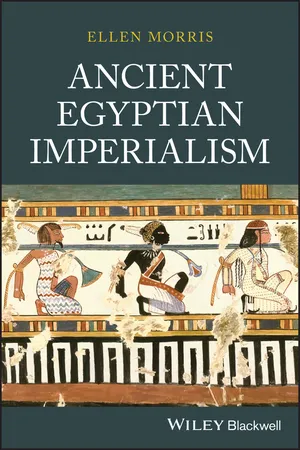
- English
- ePUB (mobile friendly)
- Available on iOS & Android
Ancient Egyptian Imperialism
About this book
Offers a broad and unique look at Ancient Egypt during its long age of imperialism
Written for enthusiasts and scholars of pharaonic Egypt, as well as for those interested in comparative imperialism, this book provides a look at some of the most intriguing evidence for grand strategy, low-level insurgencies, back-room deals, and complex colonial dynamics that exists for the Bronze Age world. It explores the actions of a variety of Egypt's imperial governments from the dawn of the state until 1069 BCE as they endeavored to control fiercely independent mountain dwellers in Lebanon, urban populations in Canaan and Nubia, highly mobile Nilotic pastoralists, and predatory desert raiders. The book is especially valuable as it foregrounds the reactions of local populations and their active roles in shaping the trajectory of empire. With its emphasis on the experimental nature of imperialism and its attention to cross-cultural comparison and social history, this book offers a fresh perspective on a fascinating subject.
Organized around central imperial themes—which are explored in depth at particular places and times in Egypt's history— Ancient Egyptian Imperialism covers: Trade Before Empire—Empire Before the State (c. 3500-2686); Settler Colonialism (c. 2400-2160); Military Occupation (c. 2055-1775); Creolization, Collaboration, Colonization (c. 1775-1295); Motivation, Intimidation, Enticement (c. 1550-1295); Organization and Infrastructure (c. 1458-1295); Outwitting the State (c. 1362-1332); Conversions and Contractions in Egypt's Northern Empire (c. 1295-1136); and Conversions and Contractions in Egypt's Southern Empire (c. 1550-1069).
- Offers a wider focus of Egypt's experimentation with empire than is covered by general Egyptologists
- Draws analogies to tactics employed by imperial governments and by dominated peoples in a variety of historically documented empires, both old world and new
- Answers questions such as "how often and to what degree did imperial blueprints undergo revisions?"
Ancient Egyptian Imperialism is an excellent text for students and scholars of history, comparative history, and ancient history, as well for those interested in political science, anthropology, and the Biblical World.
Frequently asked questions
- Essential is ideal for learners and professionals who enjoy exploring a wide range of subjects. Access the Essential Library with 800,000+ trusted titles and best-sellers across business, personal growth, and the humanities. Includes unlimited reading time and Standard Read Aloud voice.
- Complete: Perfect for advanced learners and researchers needing full, unrestricted access. Unlock 1.4M+ books across hundreds of subjects, including academic and specialized titles. The Complete Plan also includes advanced features like Premium Read Aloud and Research Assistant.
Please note we cannot support devices running on iOS 13 and Android 7 or earlier. Learn more about using the app.
Information
1
Trade Before Empire; Empire Before the State (c. 3500–2686)

Table of contents
- Cover
- Table of Contents
- Introduction
- 1 Trade Before Empire; Empire Before the State (c. 3500–2686)
- 2 Settler Colonialism (c. 2400–2181)
- 3 Military Occupation (c. 2055–1773)
- 4 Transculturation, Collaboration, Colonization (c. 1773–1295)
- 5 Motivation, Intimidation, Enticement (c. 1550–1295)
- 6 Organization and Infrastructure (c. 1458–1295)
- 7 Outwitting the State (c. 1362–1332)
- 8 Conversions and Contractions in Egypt’s Northern Empire (c. 1295–1136)
- 9 Conversions and Contractions in Egypt’s Southern Empire (c. 1550–1069)
- Epilogue
- References
- Index
- End User License Agreement